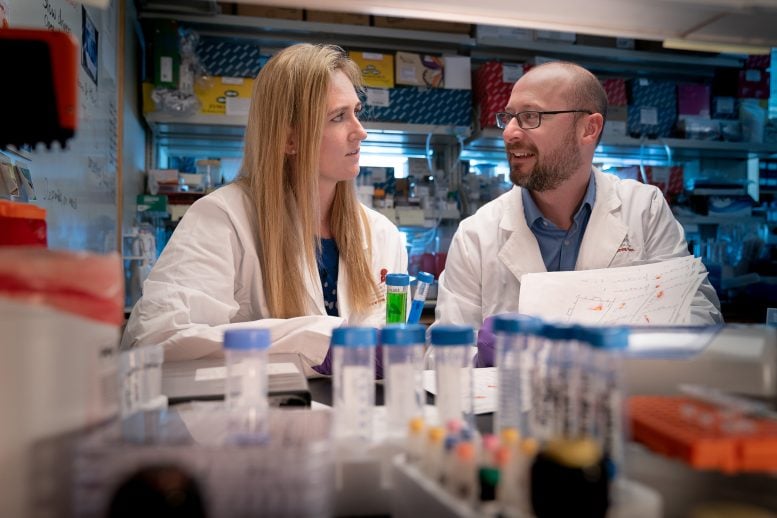By
Researchers have discovered that T cells can outlast the organism they originate from, with a unique epigenetic clock allowing them to continue proliferating through multiple lifetimes without aging. Additionally, in pediatric T-cell acute lymphoblastic leukemia (T-ALL), the T cells exhibit epigenetic ages up to 200 years, suggesting rapid proliferation can drastically age these cells, independent of the host’s chronological age.
Researchers at St. Jude Children’s Research Hospital and the University of Minnesota have discovered that the aging of T-cells is not constrained by the age of the organism, enabling these healthy cells to continue multiplying indefinitely.
Most cell types undergo functional decline after extensive proliferation and replication over the years. However, T cells appear to proliferate indefinitely without any negative effects. Researchers from St. Jude Children’s Research Hospital and the University of Minnesota have explored the distinctive ‘epigenetic clock’ that governs T-cell aging. Their findings show that T cells have the potential to survive beyond the lifespan of an organism, enduring through at least four lifetimes.
In addition, the researchers showed that healthy T cell age was uncoupled from the organism’s chronologic age. Furthermore, they determined that malignant T cells from pediatric patients with T-cell acute lymphoblastic leukemia (T-ALL) appeared to have aged up to 200 years. The findings were published in Nature Aging.
As researchers explore the process of cellular aging through repeat replicative cycles of growth, some peculiar patterns have emerged regarding T cells. “The immune system by nature must mount a rapid proliferative response to a pathogen or a tumor,” said co-corresponding author Ben Youngblood, PhD, St. Jude Department of Immunology. “And in some settings, such as endemic pathogens or chronic viral infections, this happens over and over again. That’s a lot of proliferation that these T cells undergo in the lifespan of a human.” This raised the question as to why, despite these accelerated rates of proliferation, this immune response doesn’t trigger cancer development.
The answer lies in a T cell’s unique ability to defy aging.
Epigenetic markers offer more accurate metrics for age
To study this phenomenon, the researchers made use of specific biomarkers known as epigenetic markers that accumulate over time. Like counting the rings on a tree stump in a forest, this ‘epigenetic clock’ tells a retrospective story about the life cycle of a cell independent of the organism itself. The accumulation of genetic mutations, the shortening of telomeres (the protective caps on chromosomes), and methylation patterns are currently regarded as the most accurate ways to interrogate the process of aging.

St. Jude co-corresponding authors Caitlin Zebley, MD, PhD, Department of Bone Marrow Transplantation & Cellular Therapy and Ben Youngblood, PhD, Department of Immunology, used an epigenetic clock to show that T cells can outlive their organism by at least four lifespans and that T cell acute lymphoblastic leukemia hyperproliferation results in cells which appear hundreds of years old. Credit: Courtesy of St. Jude Children’s Hospital
The researchers saw this as an ideal way to investigate the curious case of T-cell aging. “We started asking questions about what the hallmarks of aging are, specifically the epigenetic hallmarks, and how these can be applied to long-lived T cells,” he said. “One of the big questions we had was whether these epigenetic clocks are bound by the lifespan of the organism or not.”
Model shows T cells can outlive their origin organism
Through a collaboration with co-corresponding author David Masopust, PhD, University of Minnesota, the researchers found the perfect model to address their questions. This model used the same line of T cells through several mouse life cycles. “Dr. Masopust started this model assuming the cells would eventually decline, but they didn’t, they just kept going,” explains Youngblood. “This led to his foundational 10-year mouse study which we subsequently used to address whether organismal lifespan limits constrain epigenetic clocks.”
Using this model and an epigenetic clock they developed for T cells, the researchers explored the DOI: 10.1038/s43587-024-00649-5
The study’s first author is Tian Mi, St. Jude. The study’s other authors are Shanta Alli, Tae Gun Kang, Anoop Babu Vasandan, Zhaoming Wang, Ilaria Iacobucci and Charles Mullighan, St. Jude; Andrew Soerens and Vaiva Vezys, University of Minnesota; Stephen Baylin, The Sidney Kimmel Comprehensive Cancer Institute at Johns Hopkins; Peter Jones, Van Andel Institute; and Christopher Hiner, April Mueller, and Harris Goldstein, Albert Einstein College of Medicine.
The study was supported by grants from the











/https://tf-cmsv2-smithsonianmag-media.s3.amazonaws.com/filer_public/34/31/3431771d-41e2-4f97-aed2-c5f1df5295da/gettyimages-1441066266_web.jpg)








Discussion about this post